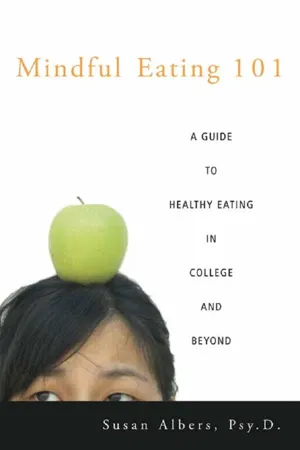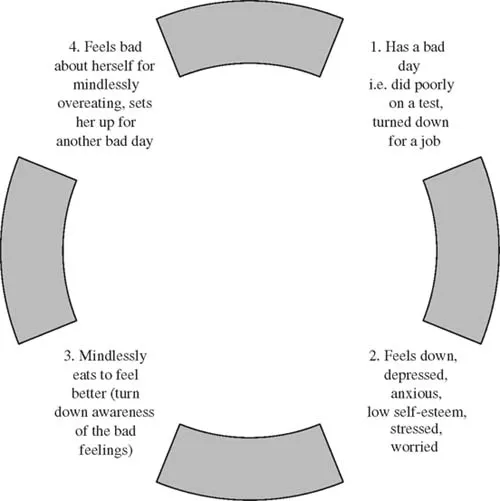
- 208 pages
- English
- ePUB (mobile friendly)
- Available on iOS & Android
eBook - ePub
About this book
In this book, Dr. Susan Albers, brings her unique approach to college students, their parents, and college staff.
Using the principles of mindfulness, Dr. Albers presents a guide to healthy eating and self acceptance that will help readers navigate the weight obsessed, diet crazed, high pressured, fast food saturated college environment, establishing patterns of eating that will form the groundwork for a healthier life well beyond college.
More than a new diet book or collection of superficial self-affirmations, this book gets at issues such as the importance of making informed choices and the value of self acceptance and good health.
Frequently asked questions
Yes, you can cancel anytime from the Subscription tab in your account settings on the Perlego website. Your subscription will stay active until the end of your current billing period. Learn how to cancel your subscription.
No, books cannot be downloaded as external files, such as PDFs, for use outside of Perlego. However, you can download books within the Perlego app for offline reading on mobile or tablet. Learn more here.
Perlego offers two plans: Essential and Complete
- Essential is ideal for learners and professionals who enjoy exploring a wide range of subjects. Access the Essential Library with 800,000+ trusted titles and best-sellers across business, personal growth, and the humanities. Includes unlimited reading time and Standard Read Aloud voice.
- Complete: Perfect for advanced learners and researchers needing full, unrestricted access. Unlock 1.4M+ books across hundreds of subjects, including academic and specialized titles. The Complete Plan also includes advanced features like Premium Read Aloud and Research Assistant.
We are an online textbook subscription service, where you can get access to an entire online library for less than the price of a single book per month. With over 1 million books across 1000+ topics, we’ve got you covered! Learn more here.
Look out for the read-aloud symbol on your next book to see if you can listen to it. The read-aloud tool reads text aloud for you, highlighting the text as it is being read. You can pause it, speed it up and slow it down. Learn more here.
Yes! You can use the Perlego app on both iOS or Android devices to read anytime, anywhere — even offline. Perfect for commutes or when you’re on the go.
Please note we cannot support devices running on iOS 13 and Android 7 or earlier. Learn more about using the app.
Please note we cannot support devices running on iOS 13 and Android 7 or earlier. Learn more about using the app.
Yes, you can access Mindful Eating 101 by Susan Albers, Psy.D. in PDF and/or ePUB format, as well as other popular books in Psychology & Abnormal Psychology. We have over one million books available in our catalogue for you to explore.
Information
Part One

Mindless Eating in College
Chapter 1
Sex, Drugs, and Rocky Road Ice Cream
Opening Up Awareness
“I despise William Dreyer,” lamented Jane, a college student and one of my psychotherapy clients. With a scowl, she said, “William is responsible for making my life miserable. Well … William, economics class, and my psycho roommate, in that order.” She crossed her arms and slumped down in the office chair. Jane had been my client at a college counseling center for about three months. I wracked my brain for a moment and silently reviewed in my head all the stories she had told me about her friends, enemies, and ex-lovers. No William came to mind.
Who is William Dreyer, I asked?
Jane explained that this mystery man first became the object of her hatred while she was writing a paper for her business economics class on entrepreneurs. “William Dreyer is the coinventor of Rocky Road ice cream,” she explained in an exasperated tone. Rocky Road Ice Cream was invented by Dreyer, an ice cream maker and Joseph Edy, a candy maker around 1929. Mr. Dreyer used his wife's sewing shears to cut up the marshmallows and then sprinkled in some of Edy's candy, so the story goes. The partners named it Rocky Road in honor of the Great Depression. They wanted to give people something to smile about during such a rough time in the world.
“Sure, William wanted to make people ‘happy’ but did he realize that he would be creating rocky road-aholics” she pondered out loud? “I wouldn't have gained the freshman thirty if it hadn't been for him!” Jane said. “They have gallons, no … vats of Rocky Road Ice cream in the cafeteria dining hall. I forbid myself to even look at it but it's like a Pavlovian response. I see it and start salivating. Literally, I want to swan dive tongue first into the ten-gallon tub of ice cream filled with candy bits, chopped nuts, and gooey marshmallows. I mindlessly eat away. One bowl turns into two before I even know it. I sit in class and suddenly realize that I am daydreaming about ice cream. If I eat too much, the guilt is unbearable. I feel so full and fat. My evening is destroyed. Who can study when you have a Rocky Road hangover?”
Unfortunately, Jane's description of mindlessly overeating Rocky Road was familiar to me. She was not the only student I worked with who felt sucked into the cafeteria vortex. So many students struggle with this cycle of mindless overeating and then feeling guilty.
As she described her issue, I also had a sinking feeling deep in my gut. The legend of the freshman fifteen had struck again. The number had somehow jumped from the freshman fifteen to the freshman thirty almost overnight. In the three months I had known her, Jane didn't visibly appear to have gained any weight. She wore the same pair of faded, low rise jeans every other week. It was more likely her fear of weight gain that had gotten heavier and harder to deal with.
The Mindless Eating Cycle
Jane was not aware of what was truly causing the mindless eating issue. She thought the ice cream was the problem, but it wasn't always the real issue. Sometimes Jane just misjudging her hunger by misreading her body's cues. But, other times, she was stuck in what I call the “mindless eating cycle.” The cycle began like this. When she got a grade on a paper that fell below her expectations, she took it pretty hard. Jane had such high expectations of herself. She was a perfectionist, which made her constantly feel below par. These snags in her self-esteem caused anxiety. Often, she didn't know to manage the negative feelings. When

FIGURE 1.1 The Mindless Eating Cycle.
the “I can't do anything right feeling” returned, she sought out a quick pick-me-up. Jane got into the habit of mindlessly eating ice cream. There was a lot of the ice cream available and she knew it made her feel better. The Rocky Road ice cream distracted her from her worries and it tasted divine. But, after she'd eaten it, she'd experienced guilt and her stomach would feel very uncomfortable. This discomfort led her to feel “anxious, fat, and mad” at herself for mindlessly overeating yet again. The cycle would begin once more.
Sex, Drugs, and Rocky Road Ice Cream
When we are disappointed in ourselves or feel inadequate, we must find ways to cope with it to restore a sense of well-being. We look for something that makes us feel “okay” again. Food, sex, or other substances are high on the list of things people use to temporarily soothe their pain, boredom or stress. For college students, all of these substances are so readily accessible. Notice that food, sex, and alcohol in moderation and in healthy, legal contexts, can be enjoyable. But, in the extreme, or when they aren't kept in check, they are unhealthy dangerous, even deadly. Acting on every impulse for sex, for example, could lead to a nightmare of consequences. The same thing occurs with food. Every urge to eat is not about being hungry. So, acting on every urge to eat is not always healthy.
Sure, it's totally normal to seek out a little chocolate, ice cream, or other comfort food. We all do it. Every now and then we crave a snack that pleases the tongue and is guaranteed to make us feel good. But, when we turn to food over and over again to numb out or to get that little high, the comfort food can turn from the comfort to the problem.
Looking in my psychotherapy crystal ball, I would have predicted several things for Jane if she continued this mindless eating pattern and did not deal with her self-esteem issues, the real issue at hand. Today, she blamed poor Mr. Dreyer whose only crime was inventing delicious ice cream. By tomorrow, she was likely to be angry at Mr. Strauss, the inventor of blue jeans. Without getting a handle on the food issue, I feared she would plunge into fad dieting. Since, 35 percent of “typical dieters” progress to more problematic eating habits, the Rocky Road mindless eating had the potential to evolve into a more serious eating concern (Shisslak, Crago, and Estes 1995).
Instead, Jane created a very different future. She transformed from the “freshman thirty” phobic to someone who accepted herself and quit letting her perfectionism stand in the way. When the emotional handicap melted away, it left in its place a woman who loved ice cream unconditionally, accepted her body, and didn't let her selfesteem cripple her. Here is how she did it.

Awareness
In a nutshell, Jane's first step to overcoming her eating issues was through developing a new awareness. She paid close attention to her behavior to find out what was really driving the “mindless eating cycle.” There was a predictable pattern. When Jane had a bad day or made a mistake, she craved the ice cream. Cutting the ice cream out of Jane's diet wasn't necessary. To end the “cycle,” she had to find other ways to manage her stress, pay extremely close attention to her hunger, and get out of the habit of turning to food to feel better quickly. When she pushed the mindless eating issues of ice cream aside, she realize that there were lots of places in her life that she felt were not good enough. She became aware that feeling inadequate underscored a lot of her unhealthy, mindless eating behaviors. then, she used skills in this book to help her become a more mindful eater.
Opening Up Awareness
Although there are many avenues to opening up one's awareness, when it comes to getting control over mindless eating habits, there are two highlighted in this chapter: (1) focusing on the issue rather than pushing it away, and (2) breaking out of mindless routines. Without getting a handle on these two topics, it's unlikely that you would become conscious of what would be helpful to change. It's like catching a spelling mistake that was missed the first time a paper was proofread. Once the error has been caught, it's impossible to turn a blind eye to it or forget that it's there. But, if the error isn't even seen, the mistake can't be corrected.
What Is Awareness?
We live in a culture that pushes us to move faster and faster. PDAs, cell phones, modems, teleconferencing are just a few of the technological advances we use in our everyday lives. Yet, they are also evidence that our culture is pushing us into fast forward mode. It's a speed that is sometimes hard to keep up with it. The pace of our world falls in line with the philosophy of people movers (moving walkways) you see at airports. They imply that walking isn't good enough—walk at double speed, move faster. Staying in sync with this kind of pace prevents us from paying attention to what is going on in the moment. We are so quickly moving on to the next task that we aren't focused on what is taking place in that very second. When we aren't living in the moment it leaves little time to understand the feelings and thoughts that motivate us to do what we do.
We just try to keep up, move faster, and often can barely keep up with the pace. We end up simply going through the motions to get by. Imagine, for example, a woman who is trying to fit in all of her prerequisite classes in order to graduate with a history major in four years. She is also working twenty hours a week to pay for college and is constantly worried about how to get research assistantships. The assistantships are necessary resume builders so that she can be competitive enough to get a job. Does she ever really slow down to ask herself whether she is enjoying this? Is this degree really what she wants or is it just what her parents expect of her? Where is her life going? Is she happy? No, she doesn't stop to ask herself these questions because she is too busy keeping up with the demands of the outside world. On top of meeting the expectations of the academic world and her parents, her own desire for success pushes her to move at double speed. Like this woman, we often believe we have little time to slow down and think about our feelings. In addition to being maxed out on time, sometimes we just aren't ready to face what's going on inside.
“I'll Worry About That Tomorrow” Syndrome
Throughout the classic 1930s movie Gone with the Wind, which takes place during the Civil War, Scarlett O'Hara, the fiery Southern heroine, shares with us her philosophy on dealing with life's woes: “I can't worry about that now, I'll think about that tomorrow.” Over and over again, she determines that she just can't handle things in the moment. She shoves all her painful thoughts, including the loss of her love, Rhett Butler, right out of her head. Scarlett keeps feelings like guilt, regret, jealousy, and loss below her awareness radar.
We get the “I'll worry about that tomorrow” syndrome with so many issues in life. Consciously and unconsciously we push painful and uncomfortable things to the back of the mind, down deep into the crevices. The mind attempts to shield us from pain by shoving hurtful things to the back of the brain. It's like putting a painful break-up letter from an ex in the very back corner of the closet: it is a case of hoping that out of sight is out of mind. But, the letter is there and it can be bothersome when something makes one remember it.
In part, pushing things out of our minds is an adaptive response. If we dwelled all day long on hurtful things, our worlds would come to an abrupt halt. We couldn't function. Putting it aside helps us cope with the pain. Yet, if you don't ever come back to it and deal with the problem it can pop up when you least expect it. In the end, putting her emotional baggage aside didn't even work for Scarlett in Gone with the Wind. Eventually, she loses her husband Rhett, and it doesn't dawn on her until after he leaves her to really stop and consider her true feelings for him: She is in love with him.
While shielding awareness of problems may temporarily make us feel better, ignoring problems only makes it more difficult to find true resolution. A small problem becomes overwhelming. Let's take the example of a term paper that was due in six weeks and you put off working on it until two days before it was due. Meanwhile, every book in the library on the subject has been checked out. You are in big trouble because you may fail the class if the paper isn't turned in on time.
When there is an issue that you don't want to face, this is when you are likely to have the hardest time standing still, or being mindful. You may find yourself signing up for more school activities and social clubs. Your friends notice that you are busier than ever and don't have time to talk. Sometimes the busyness is a way of keeping away the real issue at a “safe” distance. If you stop and be still for too long, discomfort could arise and then yousreally have to think about the whys and wherefores. With mindless eating issues, you can find a million things to keep yourself so busy that you don't have time to focus on the root of the probl...
Table of contents
- Cover Page
- Endorsement Page
- Half Title page
- Title Page
- Copyright Page
- Dedication
- Contents
- Preface
- Acknowledgments
- Introduction The Food Fight
- Part One Mindless Eating in College
- Part Two Mindful Eating
- Appendix A When It's More Than Just Mindless Eating
- Appendix B Eating Mindfully at Work
- Appendix C Ten Ways for Campuses to Be More Mindful
- References
- List of Contributors